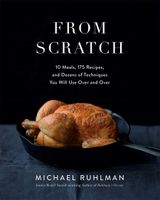Advertisement
Spatulas, Spoons, and Such
Appears in
Published 2019
And last, you need something good to stir with, something that is sturdy and has a flat edge that can sweep across the bottom of a pan. A flat-edged wooden spoon or heatproof spatula is valuable for everyday cooking. Round wooden spoons are ubiquitous and may be beautiful objects, but they are a handicap, so I manufacture and sell my own flat-edged wooden “paddles.”



The rest of your tools are a matter of preference and convenience. Here are a few of my preferred tools:
- A sturdy pair of TONGS. Make sure they grip well; those without a scalloped edge force you to squeeze food too hard, damaging it. And tongs are not just for food: I also use them to remove hot pans from the oven.
- A large PERFORATED SPOON.
- A variety of PYREX MEASURING CUPS (they’re great for storing food in as well).
- A variety of PYREX MIXING BOWLS.
- A sturdy METAL SPATULA for flipping food (I prefer a slotted one that allows fat to drain through easily).
- A heatproof rubber or silicone SPATULA.
- A good set of metal MEASURING CUPS and SPOONS. Avoid boutique-y or fancy versions, as their measurements can vary. • An instant-read THERMOMETER.
- An IMMERSION BLENDER. I use this all the time for making soups and sauces (see Winter Tomato Sauce), and the whisk attachment makes mayo a snap.
- A STANDING MIXER.
- A FOOD PROCESSOR.
- A KITCHEN SCALE. This is not strictly necessary, but if you learn how to use a scale, recipes are much easier and turn out better. And if you bake a lot, a scale is truly invaluable. I’ve designed a scale by My Weigh called the Maestro, which has a micro-scale built into it, but all the My Weigh scales are excellent, durable, and affordable. I can’t do without a scale in the kitchen.


